|
Printables |
PowerPoints |
Online exercises |
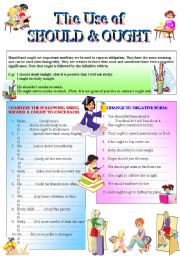
|
"VERBS" - The Use of "SHOULD" & "OUGHT TO" - When, why & how to use these auxiliary verbs - (( 30 Exercises in total )) - Elementary/intermediate - (( B&W VERSION INCLUDED ))
SHOULD and OUGHT are important auxiliary verbs used to express obligation. This worksheet focusses on teaching students "when", "why" & "how" to use the these auxiliary words. There are 30 exercises in total and Black & White version is also included. Hope you find it useful. Cheers.
Level: elementary
Age: 7-17
Type: worksheet
Downloads: 246
|
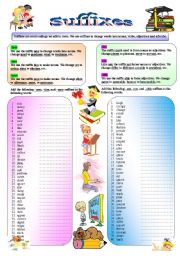
|
"SUFFIXES" - When, Why & How to use (( -ness, -tion, -ance, -ant, -ent, -able )) - (( definitions & 80 suffix exercises )) - WITH ANSWERS - elementary/intermediate - (( B&W VERSION INCLUDED ))
Suffixes are word endings we add to roots. We use suffixes to change words into nouns, verbs, adjectives and adverbs. This worksheet focusses on teaching student "when, why & how" to use the (( -ness, -tion, -ance, -ant, -ent, -able )) suffixes. The answers and black & white version are also included. Hope you find it useful. Cheers.
Level: elementary
Age: 6-17
Type: worksheet
Downloads: 458
|
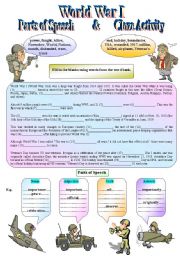
|
"PARTS of SPEECH" (nouns, adjectives, verbs, adverbs) & "CLOZE ACTIVITY" about "WORLD WAR I" - elementary/intermediate - WITH ANSWERS - (( B&W VERSION INCLUDED ))
This worksheets focusses on teaching World War I with a cloze and Parts of Speech (nouns, adjectives, verbs, adverbs) activity. It includes the answers and the black and white version. Hope you find it useful. Cheers.
Level: elementary
Age: 10-17
Type: worksheet
Downloads: 215
|
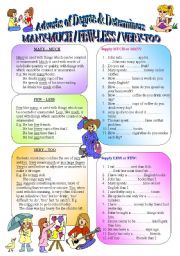
|
Adverbs of Degree & Determiners - MANY-MUCH/FEW-LESS/VERY-TOO - (( definition & 60 exercises to complete )) - elementary/intermediate - (( B&W VERSION INCLUDED ))
Students sometimes confuse the use of very and too. Very means much or in a large degree. Very is used before an adjective or an adverb to make it stronger. Too suggests something in excess, more of something than we need or can use. Too, when used with this meaning, is very often followed by an infinitive (�too� hot to �drink�, �too� difficult �to...
Level: elementary
Age: 7-17
Type: worksheet
Downloads: 314
|
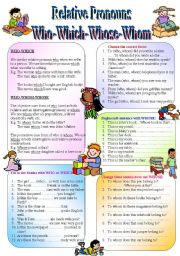
|
Relative Pronouns - When to use "Who-Which-Whose-Whom" - elementary/intermediate - (( definition & 38 exercises )) - (( B&W VERSION INCLUDED ))
We use the relative pronoun who when we refer to a person. We use the relative pronoun which when we refer to a thing. The objective case form of who (used as both relative and an interrogative pronoun) is whom. We use whom after all prepositions, a direct object of a verb, etc. This worksheets focusses on teaching students "when, why & how" to use...
Level: elementary
Age: 5-17
Type: worksheet
Downloads: 473
|
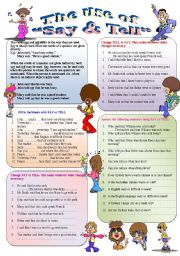
|
"VERBS" - The Use of "SAY & TELL" -The verbs "say & tell" differ in the way they are used - Elementary - (( Definition & 40 Exercises )) - (( B&W VERSION INCLUDED ))
The verbs say and tell differ in the way they are used. Say is always used when the words of a speaker are given directly. When the words of a speaker are given indirectly, both say and tell may be used. Say, however, can be used only when the person to whom the words are spoken is not mentioned. When the person is mentioned (i.e., when there is an...
Level: elementary
Age: 7-17
Type: worksheet
Downloads: 248
|
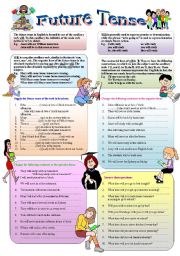
|
"FUTURE TENSE" - "will" in sentences, negative, question & contracted forms & exercises - elementary - (( Definition & 40 Exercises )) - (( B&W VERSION INCLUDED ))
The future tense in English is formed by use of the auxiliary verb will. It is generally used to express promise or determination, while the phrase �to be going to� is used to express intention or simple future action. This worksheet was developed to teach students �when, how & why� the future tense is formed. The black & white version is also incl...
Level: elementary
Age: 7-17
Type: worksheet
Downloads: 265
|
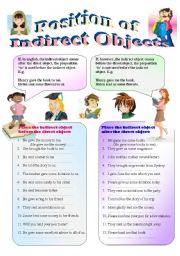
|
"THE POSITION OF INDIRECT OBJECTS" - Learn to place the indirect object before & after the direct object - Elementary/intermediate - (( B&W Version Included ))
If, in english, the indirect object comes after the direct object, the preposition �to� is used before the indirect object. If, however, the indirect object comes before the direct object, the preposition �to� is not used before the indirect object. This worksheet was developed to show �how�, �where� & �when� to place the direct & indirect object ...
Level: elementary
Age: 5-17
Type: worksheet
Downloads: 213
|
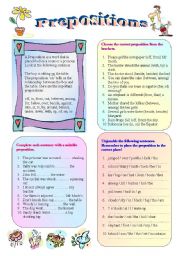
|
"PREPOSITIONS" - elementary- completing sentences, choosing correct preposition, unjumbling preposition sentences - B&W VERSION INCLUDED
Prepositions are words that are placed before a noun or a pronoun. This worksheet focusses on teaching students how to put the correct preposition within the correct context & sentence. The activities include: completing sentences with the correct preposition, choosing the correct preposition in a sentence and unjumbling sentences which have a prep...
Level: elementary
Age: 7-17
Type: worksheet
Downloads: 100
|
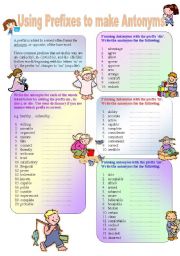
|
"USING PREFIXES TO MAKE ANTONYMS" - learning how to form Antonyms using un-, in-, dis- prefixes - ELEMENTARY - B&W VERSION INCLUDED
A prefix is added to a word often forms the antonym, or opposite, of the base word. The common prefixes that act in this way are un- (unlucky), in- (invisible), and dis- (dislike). Before words beginning with the letters �m� or �p�, the prefix �in� changes to �im� (impolite). This worksheet focusses on forming antonyms using the un-, in-, dis- pref...
Level: elementary
Age: 7-17
Type: worksheet
Downloads: 299
|
|
|
|
|